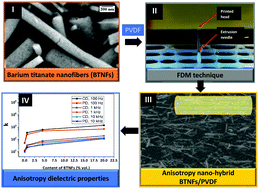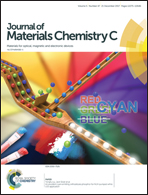3D-printed barium titanate/poly-(vinylidene fluoride) nano-hybrids with anisotropic dielectric properties
Abstract
Electrospun BaTiO3 nanofibers (BTNFs) are synthesized and blended in a poly(vinylidene fluoride) (PVDF) matrix to obtain a flexible nano-hybrid composite with high dielectric constant (flexible high-k). The blending is performed with different BTNF contents (0.6, 4.5, 20 vol%). The rheological properties of the starting materials are optimized to shape the hybrid by the precision-extrusion-based fuse deposition modeling technique. The 3D-printed BTNFs allow complex shapes with different degrees of fiber alignment as the result of printing shear stress and the chemical composition of the starting material. The dielectric properties of the nano-hybrid are controlled by anisotropy with an enhancement in the nanofiber cross direction (⊥), where the dielectric constant k⊥ at 1 kHz is increased to ca. 200 from 13 of the PVDF matrix.



 Please wait while we load your content...
Please wait while we load your content...